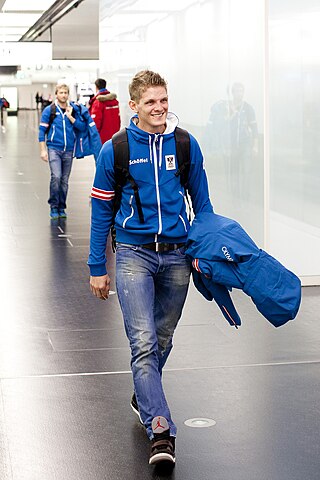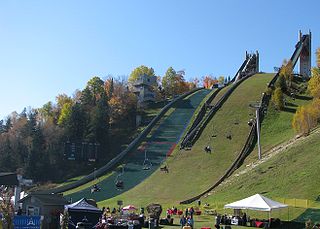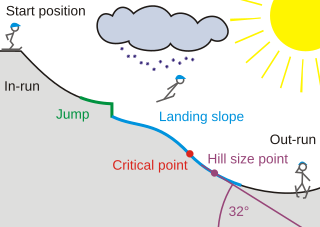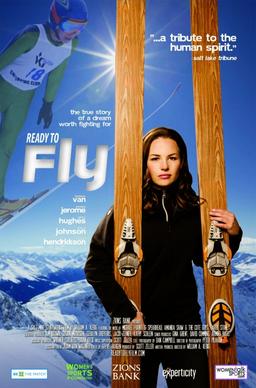
Nordic combined is a winter sport in which athletes compete in cross-country skiing and ski jumping. The Nordic combined at the Winter Olympics has been held since the first Winter Olympics in 1924, while the FIS Nordic Combined World Cup has been held since 1983. Many Nordic combined competitions use the Gundersen method, where placement in the ski jumping segment results in time (dis)advantages added to the contestant's total in the cross-country skiing segment.

Ski jumping is a winter sport in which competitors aim to achieve the farthest jump after sliding down on their skis from a specially designed curved ramp. Along with jump length, competitor's aerial style and other factors also affect the final score. Ski jumping was first contested in Norway in the late 19th century, and later spread through Europe and North America in the early 20th century. Along with cross-country skiing, it constitutes the traditional group of Nordic skiing disciplines.

Holmenkollbakken is a large ski jumping hill located at Holmenkollen in Oslo, Norway. It has a hill size of HS134, a construction point of K-120, and a capacity for 70,000 spectators. Holmenkollen has hosted the Holmenkollen Ski Festival since 1892, which since 1980 have been part of the FIS Ski Jumping World Cup and 1983 the FIS Nordic Combined World Cup. It has also hosted the 1952 Winter Olympics and the FIS Nordic World Ski Championships in 1930, 1966, 1982 and 2011.

The FIS Nordic World Ski Championships is a biennial Nordic skiing event organized by the International Ski Federation (FIS). The World Championships was started in 1925 for men and opened for women's participation in 1954. World Championship events include Nordic skiing's three disciplines: cross-country skiing, ski jumping, and Nordic combined. The Winter Olympics from 1924 to 1980 were also the Nordic World Ski Championships. This meant that the Olympic champions were also World champions and received an additional medal from the International Ski Federation (FIS). Since 1985, the World Championships have been held in odd-numbered years.

Thomas Morgenstern is an Austrian former ski jumper who competed from 2002 to 2014. He is one of the most successful ski jumpers of all time, having won the World Cup overall title twice with 23 individual wins, the Four Hills Tournament and the Nordic Tournament once each, eight World Championship gold medals, and three Winter Olympic gold medals.

Kazuyoshi Funaki is a Japanese former ski jumper. He ranked among the most successful sportsmen of its discipline, particularly in the 1990s. Funaki is known for his special variant of the V-style, in which the body lies flatter between the skis than usual.
Masahiko Harada is a Japanese former ski jumper. He is best remembered for a meltdown at the 1994 Winter Olympics in Lillehammer, which cost the Japanese national team a victory, and his subsequent redemption at the 1998 Winter Olympics in Nagano; the latter of which led to him being affectionately called "Happy Harada".

Noriaki Kasai is a Japanese ski jumper. His career achievements include a gold medal at the 1992 Ski Flying World Championships, winning the 1999 Nordic Tournament, individual silver medal at the 2014 Winter Olympics, and two individual bronze medals at the 2003 Ski Jumping World Championships.

The Lake Placid Olympic Ski Jumping Complex, also known as the MacKenzie Intervale Ski Jumping Complex, consists of HS100- and HS128-meter ski jump towers built for the 1980 Olympic Games in Lake Placid, New York, United States. Modernized and lengthened in 2021, they are the only jumps in North America homologated for winter and summer jumping competitions. The complex is operated by the Olympic Regional Development Authority.
The men's individual large hill/10 km Nordic combined competition for the 2010 Winter Olympics in Vancouver, Canada was held at Whistler Olympic Park in Whistler, British Columbia on 25 February.
The men's team large hill/4 x 5 km Nordic combined competition for the 2010 Winter Olympics in Vancouver, Canada was held at Whistler Olympic Park in Whistler, British Columbia on 23 February. The Austrian team of Michael Gruber, Christoph Bieler, Felix Gottwald, and Mario Stecher were the defending Olympic champions. Gruber retired after the 2007-08 season. Gottwald originally retired after the 2006-07 World Cup season, but came out of retirement in May 2009 to compete for the 2009-10 World Cup season including the 2010 Games. The defending world champions were the Japanese team of Yūsuke Minato, Taihei Kato, Akito Watabe, and Norihito Kobayashi. The last World Cup event prior to the 2010 Games in this format took place on 12 December 2009 in Harrachov, Czech Republic, but that event was cancelled on 4 December 2009 to warm weather and lack of snow. A team normal hill event took place prior to the 2010 Winter Games in Schonach, Germany on 24 January 2010 and was won by the German team of Georg Hettich, Eric Frenzel, Björn Kircheisen, and Tino Edelmann.
The men's normal hill individual ski jumping competition for the 2010 Winter Olympics in Vancouver, Canada was held on 12 and 13 February 2010 at Whistler Olympic Park in Whistler, British Columbia. It was the first medal event of the 2010 Games.

The construction point, also known as the K-point or K-spot and formerly critical point, is a line across a ski jumping hill. It is used to calculate the number of points granted for a given jump. It is also called calculation point or calculation line.

Igman Olympic Jumps, also known as Malo Polje, is a defunct ski jumping hill on the mountain of Igman in Ilidža, Sarajevo, Bosnia and Herzegovina. It consists of a large hill with a construction point (K-point) of 112 meters (367 ft) and a normal hill with a K-point of 90 meters (295 ft). Construction started in 1980 and the venue opened in 1982 to host ski jumping and Nordic combined at the 1984 Winter Olympics. The large hill event saw Finland's Matti Nykänen set the hill record of 116.0 meters (381 ft) in front of 90,000 spectators. No other International Ski Federation (FIS) sanctioned competitions have taken place at the hills. During the Siege of Sarajevo, the hills became a battleground and have since not been used. However, there are plans to rebuild the in-run, expand the large hill and build new spectator stands and visitor facilities.

Carina Vogt is a German former ski jumper.

Ready to fly is an American documentary by William A. Kerig following the true story of the fight of American women's ski jumping athletes Lindsey Van, the rest of her U.S. Women's Ski jumping Team members, Jessica Jerome, Alissa Johnson, Abby Hughes, Sarah Hendrickson and many other elite ski jumping athletes around the world to be part of the Olympic Winter Games. It was first screened during the 2013 Banff Mountain Film Festival.












